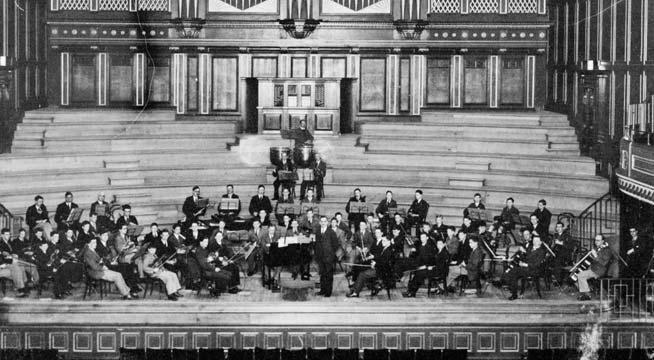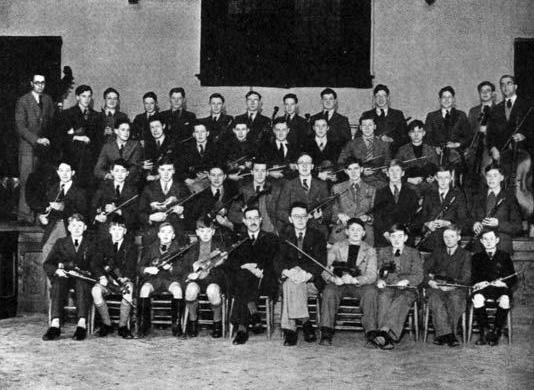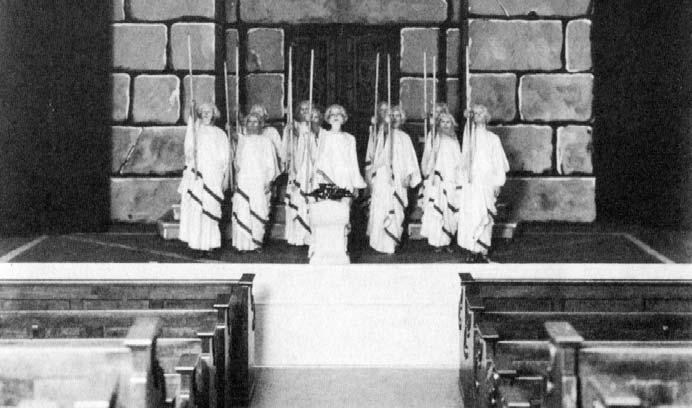
8 minute read
A History of the RGS in Its People
from ONA 98
A HISTORY OFTHE RGS IN ITS PEOPLE
by David Goldwater (51-62)
Advertisement
As with the piece on former Headmaster, Samuel Logan (1883-1912) (see Issue 97), this article arose out of another example of serendipity, in this instance, a lunchtime organ recital in July at St Nicholas Cathedral, Newcastle. The recital was by ON Katy Silverman (née McDermott) (06-08), now a professional organist and conductor and currently the 2016-17 Guildford Cathedral organ scholar. One of her pieces was Galliard for a Festive Occasion by Arthur Milner (26-48).
Arthur Milner at a concert, City Hall, Newcastle
Arthur Frederick Milner Head of RGS Music
Arthur Milner was brought to the school in 1926 by the then Headmaster, ER Thomas (22-48). Though born in Manchester, he came with his parents to Tyneside as a small boy, was educated at Dame Allan’s and never left the North East. He had lectured in Music at Armstrong College, Newcastle (then part of Durham University) and taught at Lemington Adult School. In his 22 years as Head of Music, he transformed the subject at RGS from almost nothing to the nationally recognised excellence we now take for granted. One upright piano and the Sutherland war memorial organ were the only instruments the school possessed, singing in the Junior School and the first senior year being the only musical activity. He developed the potential of music well ahead of other schools, so much so that the Board of Education chose the RGS to demonstrate to overseas visitors what was being achieved in music at an English school.
A course in Musical Appreciation was soon initiated for the Sixth Form and outside the curriculum, the Senior Treble Choir became one of the first voluntary activities in the school. The House Music Competition followed and a Second and Third Orchestra in the mid-30s reflected the enthusiasm Arthur Milner was bringing to boys, many aspiring to membership of the Second or even the First Orchestra. Visiting teachers were recruited to meet the growing demand as a large stock of instruments was gradually purchased with the support of the Governors, including a Bechstein grand piano
From 1932, Mr Milner was conductor of the Northumberland Orchestral Society, established in 1877, reviving the orchestra after the war and ultimately handing on the baton to his successor at RGS.
By the outbreak of war in 1939, his huge achievement was plain to see and the Christmas Concert, amongst many others performances, demonstrated how the First Orchestra could perform together with items from chamber music and songs by the Senior Treble Choir. The school’s evacuation to Penrith on 1 September 1939 lasted until July 1944. Here, ‘difficulties were turned into opportunities’, and although numbers decreased, school music thrived. Concerts were given around the area for wartime fundraising and many older boys and staff were invited to the homes of Penrith musicians to practise. Arthur Milner, an accomplished pianist and organist, would play his beloved Mozart. He initiated a series of Workers Educational Association (WEA) Musical Appreciation classes in the town which evolved into a music club after the school’s return to Newcastle. Sadly, he and his wife Elizabeth lost their only son, Brian, whilst at Penrith in 1944.
Despite depleted numbers with many staff enlisted, the strong ethos of RGS music, combined with the need, in these difficult surroundings for social cohesion, continued to flourish. When, at last, the school returned to Eskdale Terrace at the end of summer 1944, there was enough impetus for a further burgeoning of school music and when Arthur Milner’s retirement took place, together with that of ER Thomas in 1948, the tradition which endures to this day had been firmly established. He was succeeded by Jack Wolstenholme (48-75) (see Issue 88), who continued Milner’s work with no less energy and enthusiasm.
Arthur Milner at a concert, City Hall, Newcastle


Arthur Milner, The Novocastrian, April 1940. Photo courtesy of F Kenyon, Esq. of Penrith
My cousin, Stephen Goldwater, a pupil of Milner, recalls that for some time the next pupil waiting at his house in Balmoral Terrace, Gosforth, was Peter Taylor (38-49) whose musical talents were regularly noted in NOVOS of the 40s and 50s. In the late 50s and early 60s Milner had around 20 organ pieces published, mainly by Novello and Ashdown. One of them was the Galliard for a Festive Occasion played by Katy Silverman.
Charles Avison is unquestionably the single most important figure in Newcastle’s musical history. Little was known about Avison until a biography was written by Arthur Milner and published in The Musical Times in 1954, after spending five years researching into the composer’s background and early life. In ‘retirement’, Arthur Milner continued his musical career at the Newcastle Journal as its music correspondent and critic and taught piano, organ and music theory. He was an FTCL (Fellowship of Trinity College London) (piano), ARCM (Associate of the Royal College of Music) (piano) and ARCO (Associate of the Royal College of Organists). He held a Durham DMus by examination.
Recollections of a great RGS teacher and musician
Joseph W Pegg wrote in his Newcastle’s
Musical Heritage, 2003: ‘I well remember a Sunday concert by the Northumberland Orchestral Society in March 1946, conducted by Arthur Milner, one-time professor at the Newcastle Conservatoire, that opened with the Overture The Hebrides by Mendelssohn played without trombones.
All Right on the Night – Glasgow Herald
9 December 1935: ‘Some of the trials of the conductor of a School Orchestra were indicated by Mr Arthur Milner, of the Royal Grammar School, Newcastle, at a meeting of school music teachers, in Edinburgh on Saturday. Two may be mentioned. On the evening of a concert the principal violinist broke his thumb in a boxing match. And when writing a part for the horn, Mr Milner had to confine himself to those notes which the player would really guarantee he could play’.
One merely has to flick through the pages of NOVO during Arthur Milner’s long career to observe the huge contribution he made to RGS music. In 1927: ‘the school echoed in the lunch hour with noises, sounds and sweet airs.’ 1932: December saw a remarkable production of Aeschylus’ Agamemnon in the Main Hall, translated by AA Le M Simpson (29-45) (who founded the XXl Club), with music by Arthur Milner. 1943 sees Mr Milner involved in the Junior Players, as well as holding a discussion on, ‘the controversy over jazz and classical music’ with some common ground apparently established with the help of the late Bill Weeks (35-44) who would recall Arthur Milner’s tacit support for those boys who were jazz fans during the evacuation. The July 1944 NOVO noted, ‘hosts and hostesses enjoyed another of Mr Milner’s pianoforte recitals in the Wordsworth Hall…the last of the performancesto be given in Penrith’. Back in Newcastle, school music gradually improved to attain its pre-war standard. In 1945, as the school reached its Four-hundredth Anniversary, he had established ‘two musical appreciation classes, attended by both ‘artists’ and ‘scientists’, as well as the re-establishment of the Gramophone Club.
I shall close with an item which would point the way to the future successes of RGS Music. The First Orchestra and Senior Choir broadcast from the New Bridge Street BBC Studio in 1948 on the Children’s Hour. The performance included The Caliph of Baghdad by François Adrien Boieldieu and Purcell’s Nymphs and Shepherds. The BBC issued a recording which was heard a week later by the performers. In the December NOVO it was noted, after journeying to the studios and rehearsing for over an hour, ‘the Choir journeyed to Fenwick or Woolworths in search of ice cream or lemonade’ and ‘The brass section relieved the monotony of the orchestra’s tuning up by playing bits of ragtime.’ NOVO December 1948: ‘And what of the man himself? To the School at large a familiar figure up at the organ, well-nigh infallible, equal to all sudden demands for the School Song or ‘[God save] The King’. To all sincere musicians a friend, an authority and a guide.’ ‘…few can have escaped that mild reproof, ‘You child of Beelzebub!’’ ‘Rehearsal under his baton has always meant a good deal of fun and a lot of hard work.’
Arthur Milner’s work has written a memorable page in the history of the school.
Aeschylus’ Agamemnon, Main Hall, December 1932

My Recollections of Arthur Milner
by Katy Silverman (06-08)
I was first introduced to the music of Arthur Milner soon after I started playing the organ at the age of 13, by my teacher and then director of music at St George’s Cullercoats, Paul Ritchie (himself a published composer of choral and organ works). However, it wasn’t until I was researching the background to my recital in July that I learnt what a longstanding connection Milner had with the RGS and it is wonderful to read more about his work here in David’s article. We resurrected Milner’s House Music Competition in 2007, and I have great memories of two years worth of competitions –probably the most unforgettable being a rousing performance of Yellow Submarine from Collingwood house of which I was a very proud member! I was also a Music Prefect in Upper Sixth and there was a lovely group of six of us all taking A Level Music together. As I went on to study Music at university, I have much to thank the RGS music department for and am very glad to be able to continue to represent music from the North East in my performances.






